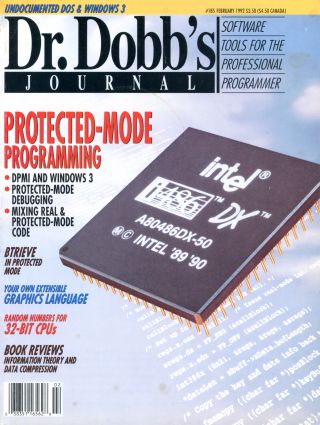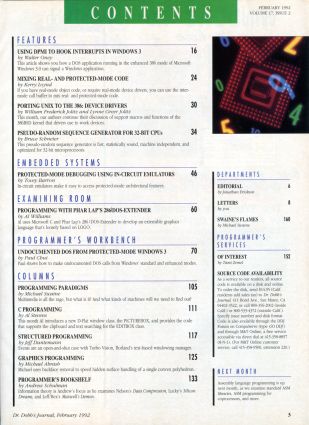
p.6 EDITORIAL
[author : Jonathan Erickson] #Edito
TABLE OF CONTENTS
FEATURES
p.16 USING DPMI TO HOOK INTERRUPTS IN WINDOWS 3
[author : Walter Oney]
This article shows you how a DOS application running in the enhanced 386 mode of Microsoft Window's application.
p.24 MIXING REAL-AND PROTECTED-MODE CODE
[author : Kerry Loynd]
If you have real-mode object code, or require real-mode device drivers, you can use the intermode call buffer to mix real- and protected-mode code.
p.30 PORTING UNIX TO THE 386: DEVICE DRIVERS
[author : William Frederick Jolitz and Lynne Greer Jolitz]
This month, our authors continue their discussion of support macros and functions of the 386BSD kernel that drivers use to work devices.
p.34 PSEUDO-RANDOM SEQUENCE GENERATOR FOR 32-BIT CPUS
[author : Bruce Schneier]
This psuedo-random sequence generator is fast, statistically sound, machine independent, and optimized for 32-bit microprocessors.
EMBEDDED SYSTEMS
p.46 PROTECTED-MODE DEBUGGING USING IN-CIRCUIT EMULATORS
[author : Tovey Barron]
In-circuit emulators make it easy to access protected-mode architectural features.
EXAMINING ROOM
p.60 PROGRAMMING WITH PHAR LAP'S 286 DOS-EXTENDER
[author : Al Williams]
Al uses Microsoft C and Phar Lap's 286 DOS-Extender to develop an extensible graphics language that's loosely based on LOGO.
PROGRAMMER'S WORKBENCH
p.70 UNDOCUMENTED DOS FROM PROTECTED-MODE WINDOWS 3
[author : Paul Chui]
Paul shows how to make undocumented DOS calls from Windows' standard and enhanced modes.
COLUMNS
p.105 PROGRAMMING PARADIGMS
[author : Michael Swaine]
Multimedia is all the rage, but what is it? And what kinds of machines will we need to find out?
p.111 C PROGRAMMING
[author : Al Stevens]
This month Al introduces a new D-Flat window class, the PICTURBOX, and provides the code that supports the clipboard and text searching for the EDITBOX class.
p.117 STRUCTURED PROGRAMMING
[author : Jeff Duntemann]
Events are an open-and-shut case with Turbo Vision, Borland's text-based windowing manager.
p.125 GRAPHICS PROGRAMMING
[author : Michael Abrash]
Michael uses backface removal to speed hidden surface handling of a single convex polyhedron.
p.133 PROGRAMMER'S BOOKSHELF
[author : Andrew Shulman]
Information theory is Andrew's focus as he examines Nelson's Data Compression, Lucky Silicon Dreams, and Leff/Rex's Maxwell's Demon.
DEPARTMENTS
p.8 LETTERS
[author : you]
p.160 SWAINE'S FLAMES
[author : Michael Swaine]
PROGRAMMER'S SERVICES
p.152 OF INTEREST
[author : Tami Zemel]
